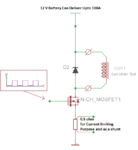Warpspeed
Advanced Member level 5
- Joined
- May 23, 2015
- Messages
- 2,366
- Helped
- 773
- Reputation
- 1,548
- Reaction score
- 789
- Trophy points
- 1,393
- Location
- Melbourne, Australia
- Activity points
- 20,317
Saturation and permiability are quite independent.
Both depend on the characteristics of the particular material, which we cannot be sure about.
All you can do is run an actual saturation test.
That is not difficult to do, and your 3 amp bench supply will be ideal to test to several tens of peak amps.
Here is a post in another thread thread in which I tell how to do it.
Scroll down to post #24
https://www.edaboard.com/threads/350084/
Both depend on the characteristics of the particular material, which we cannot be sure about.
All you can do is run an actual saturation test.
That is not difficult to do, and your 3 amp bench supply will be ideal to test to several tens of peak amps.
Here is a post in another thread thread in which I tell how to do it.
Scroll down to post #24
https://www.edaboard.com/threads/350084/



